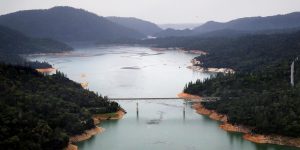We know earthquakes are a threat – what else should we consider when making real estate decisions? Hat tip to daytrip for sending this in:
In December 1861, as a California drought was wearing into its fifth year, farmers on the West Coast were all asking for one thing for Christmas: rain. And boy did they get it.
For 43 days rain and snow fell across the state, causing rivers to surge their banks, turning the 300-mile long, 20-mile-wide Central Valley into an ice-cold inland sea. LA got 66 inches. So deep were Sacramento’s floodwaters that the capital had to be relocated to San Francisco. With a quarter of the economy underwater the state was forced into bankruptcy. Thousands of people died. It was the most violent flooding California had ever seen, and no storms have come close to topping it since.
Soil cores and climate models tell scientists that megafloods like this one have happened about once every 200 years. Which, if you’re doing the math, means the state is due.
That’s not the bad news. The bad news is that by the middle of the century, a megaflood could be striking California every couple of decades.
That’s according to a new study out today in Nature Climate Change, which predicts up to a 100 percent increase in extreme precipitation swings across California over the next seven decades. “A lot of people have done the version of the analysis where they look at the mean precipitation change, and find it’s close to zero or uncertain,” says Daniel Swain, a climate scientist and the study’s lead author. That makes it seem like things will stay about the same going forward.
But looking at each kind of event separately—the droughts and the deluges—you come to very different conclusions. Using climate model data from the National Center for Atmospheric Research’s supercomputers, researchers at UCLA looked at how and when snow and rain will fall from the sky. “There’s actually a huge change in the character of precipitation variability,” says Swain.
California was a land of extremes well before humans started pumping carbon dioxide into the atmosphere, but Swain says that natural drought-to-deluge boomerang is already turning into whiplash.
Between 2013 and 2016 the state experienced the driest three years in state history. Toward the end of 2016 a cluster of atmospheric river storms set rainfall records, causing mudslides, a major bridge collapse, and a failure on the Oroville Dam’s primary spillway. Months later the largest wildfire in state history burned 280,000 acres outside of LA followed shortly by more floods and deadly mudslides. This caroming between extremes year to year is only expected to increase as a warming climate allows the atmosphere to hold exponentially more water. Literally.
“The physical laws of thermodynamics raise the ceiling on the intensity of these precipitation events in a really robust, reliable way,” says Swain. “It doesn’t mean it will always be raining, but it does mean that eventually all that water has to fall out somewhere.”
Link to Full Article




My post from 2012:
http://exurbannation.blogspot.com/2012/12/real-doom.html
Lots of good links and comments.
The flooding is just part of living in desert scrub land. Due diligence when buying a house will keep people from getting hosed. Helps to know, when all heck breaks loose, which area of Cali takes the brunt. Btw, the people who bought in Malibu are homesteading on soil guaranteed to turn their roads into a massive slip ‘n slide next time we get a big fat month of torrential rain.
It would be nice to see nature clear the riff raff out of there for good, so the President could declare Malibu a state park, and a challenging golf course, as it should have been. I pray I get to see it happen in my lifetime, Trump willing.
Ah yes, the hundred year flood line. Just like the odds are 36 to 1 on 36 coming up again on the next spin of the ball at roulette but 200 years is pushing it a bit. I hope all the bubbleinfo folk bought houses at the top of the hill!